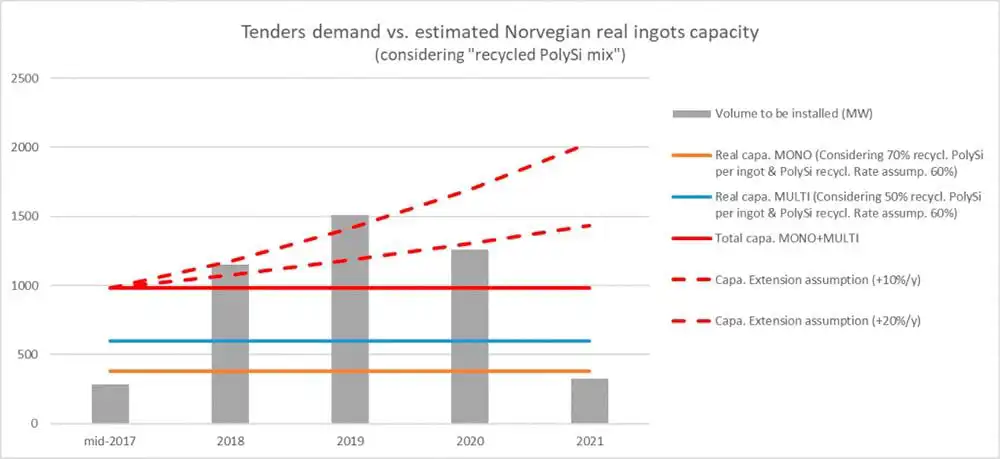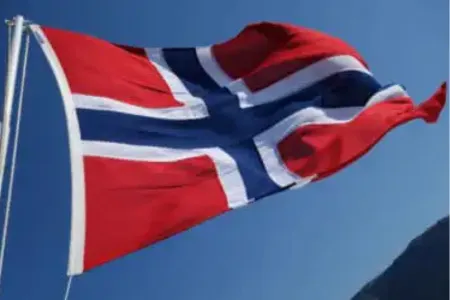CARBON FOOTPRINT & FRENCH PV TENDERS – The Norwegian question
This article is part of the Carbon Footprint series:
- Rapid introduction to the CRE bidding mechanism
- Introduction to Simplified Carbon Footprint: calculation
- LCA and optimized carbon values: method 2 & documentary process
- Impact of the manufacturing country and process: what are the optimization targets?
- Low carbon supply: The Norwegian question
- Low carbon modules: what are the promising alternatives
- Is Polysilicon FBR a solution for the French market?
In order to offer modules with the lowest carbon footprint, most of the modules suppliers source materials from Norway:
In order to offer the module with lowest possible carbon level, most of module manufacturers have offered to their customers for CRE3 panels that are produced out of ingots made in Norway, which are made out of a high proportion of recycled poly-silicon (of up to 70% for mono and 40-50% for polycrystalline)
As a matter of fact, to improve the carbon impact (and the cost structure at the same time) of their products, the ingot manufacturers recycle the waste from the ingots and wafers (kerf-loss) and reuse them as (recycled) polysilicon, in order to manufacture new ingots. The recycling is done on the same manufacturing site so, in that case, in Norway.
As a result, the CRE AOs (call for tenders) rely strongly on the Norwegian production / recycling capacity.
The norwegian capacity cannot match with the french tenders needs:
Let’s consider a conservative recycling rate assumption of 50%, we obtain the production capacity curves below (Figure 1). These production capacities compared to the awarded volume during the AOs, shows a clear gap between offer and demand. It is therefore appropriate to consider an alternative supply chain.

Strict rules to follow in order to change the modules:
As indicated in Chapter 1, a winning project must stick to the products and suppliers specified in the file at the time of filing (Modules’ commercial reference(s), manufacturer(s) and place(s) of manufacturing of the modules, cells, wafers and poly-silicon), as well as the ECS value.
In the event of a supplier that is unable to deliver its products or components, it is possible for the project winner to change supplier. But this request is heavy and very bureaucratic. It must be addressed to the prefect ruling on the project site region. He has 3 months to reply favorably or not (if no reply within this period the application is deemed as denied).
The application must be accompanied by (sometimes hard to obtain) evidences proving the manufacturer’s inability to deliver the given modules or to supply the named components. Changing modules or components must not increase the ECS values that are entered in the registered file. Thus, the following possible scenarios if the project owner wants to change its supplier
If the alternative product features:
- ECS license without star, with a lower or equal final value: OK
- ECS license with stars (“provisional”), with a lower or equal final value: OK, proceed to a new certificate
- ECS license with or without stars, with higher final value: OK, proceed to certification and potentially also LCA
The winner sticks with the same supplier of modules but one or more components have been changed
- OK, you should proceed to a new certification, and probably also LCAs
Consequences: a significant part of the awarded project pipe-line could be threatened if CRE does not soften rules to change modules supplier.
Some module manufacturers are unable to provide the low-carbon supply, which they promised when they submitted their project request document. A bottleneck has been created and with the deadlines approaching pressure is increasing. Developers sometimes find themselves taken as hostage by this situation and therefore forced to wait and hope that the supply situation can be solved out or to look for alternatives and hope that the regional prefects will accept the changes in the offered modules.
On this last point, their only chance of succeeding is to find an alternative that complies with the crucial condition for any modification: an ECS value less than or equal to that stated in the application file. However, when the developer submitted his project with modules made thanks to a Norwegian upstream supply chain it is difficult, from an ECS point of view, to find an comparable alternative.
ECS: Simplified Carbon Evaluation
